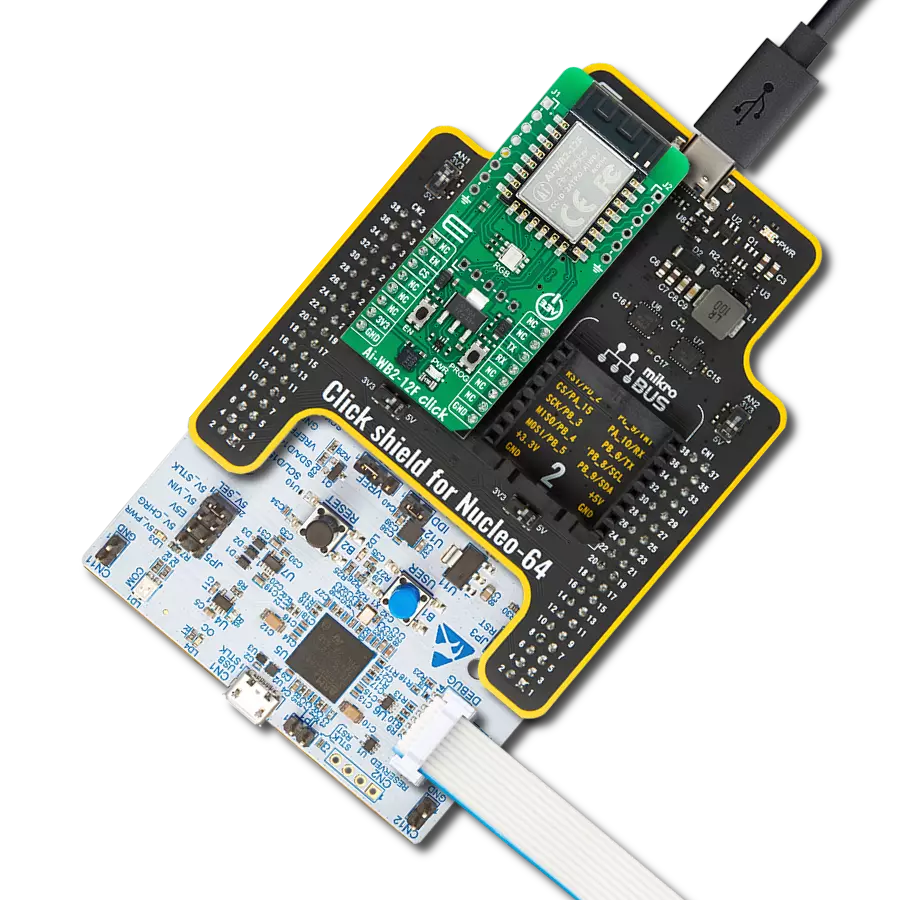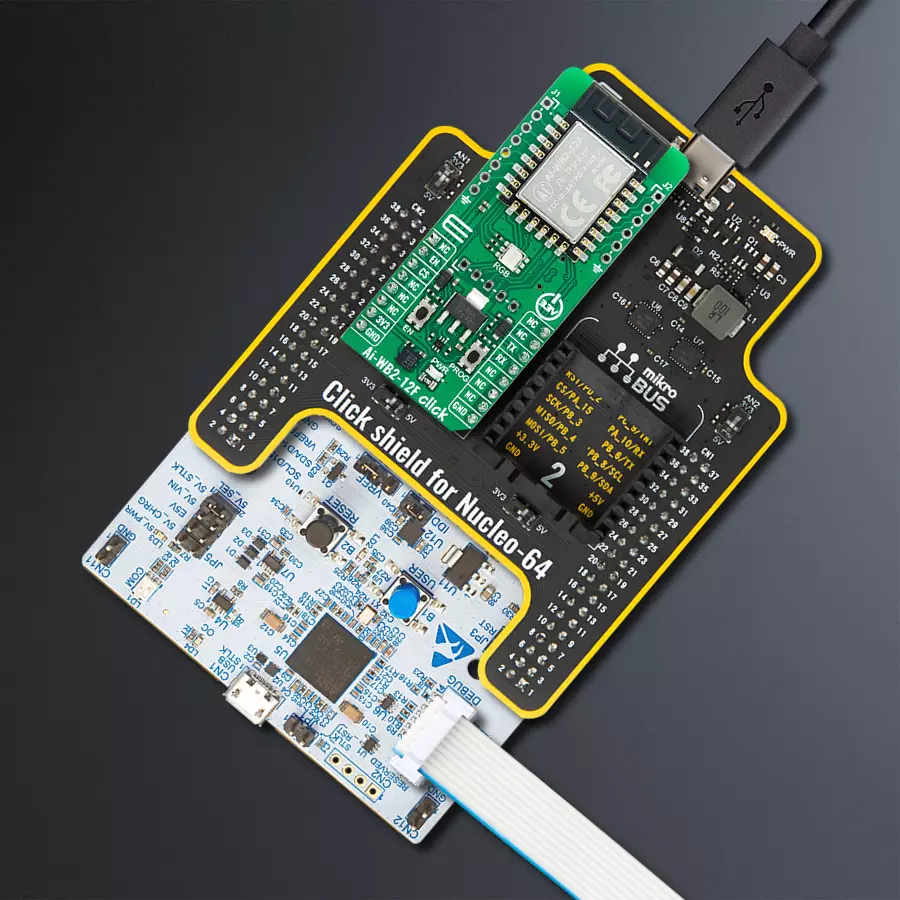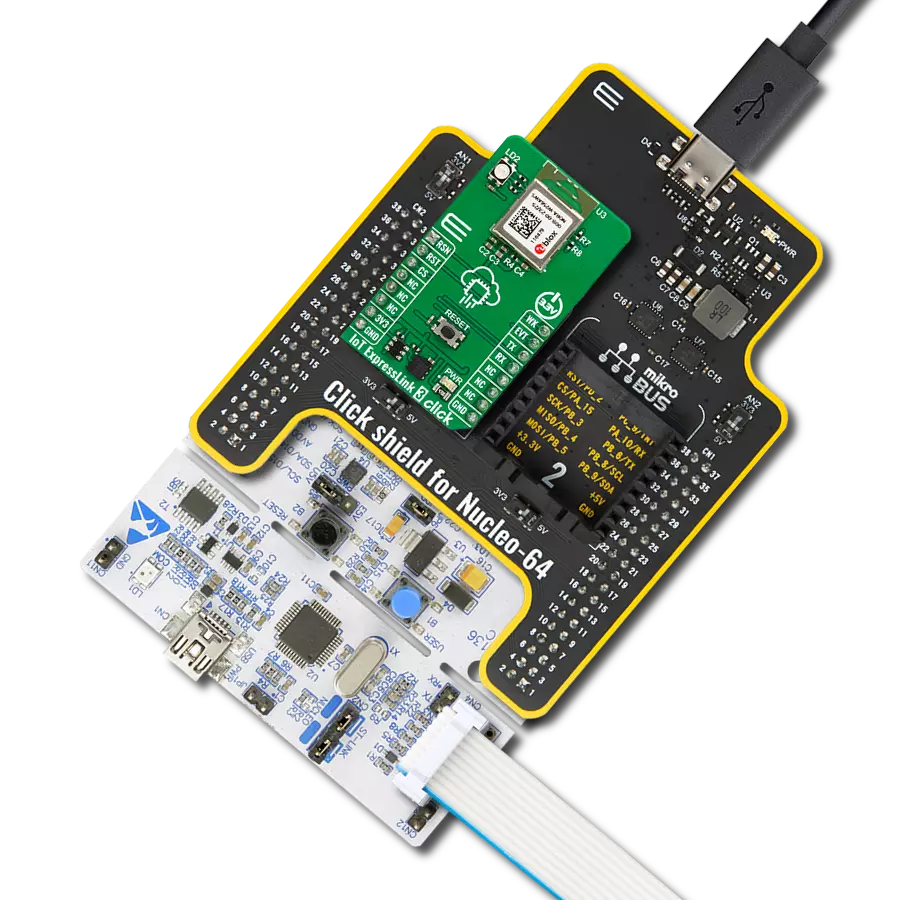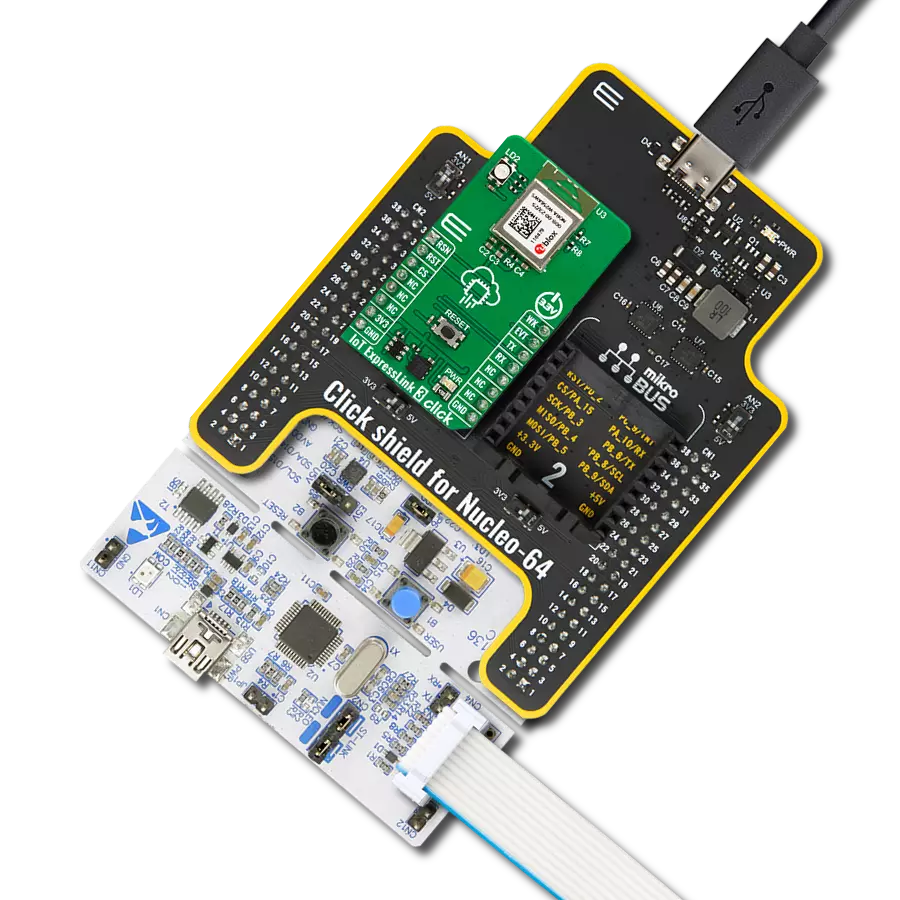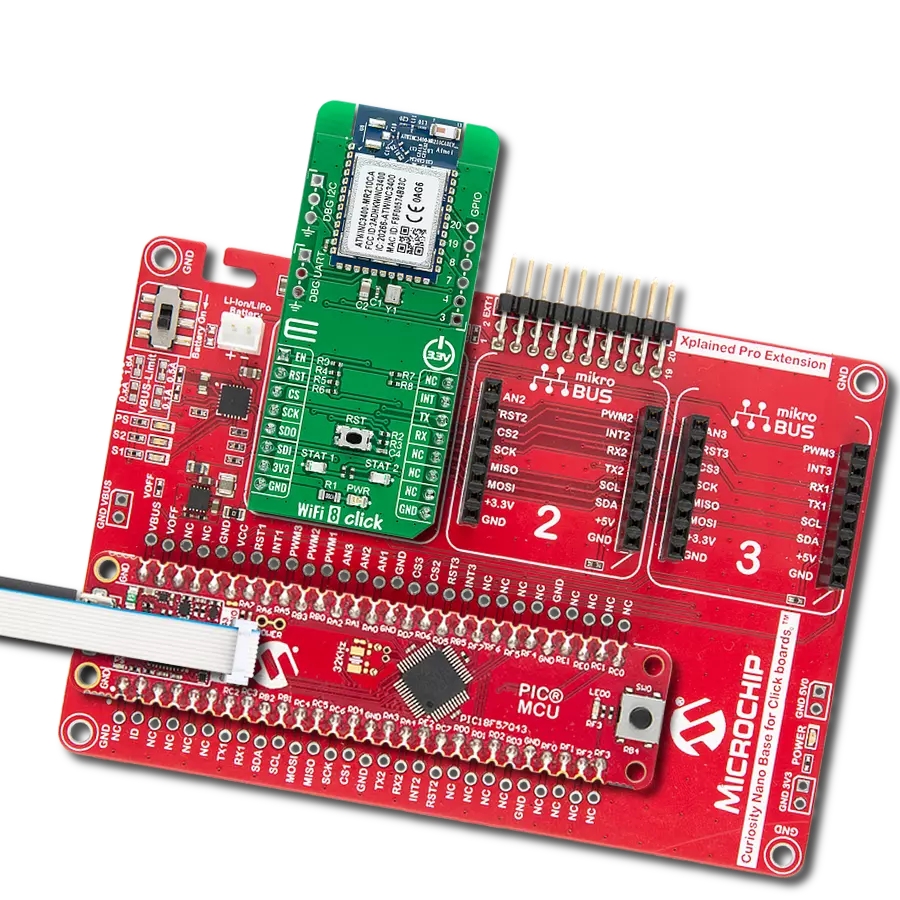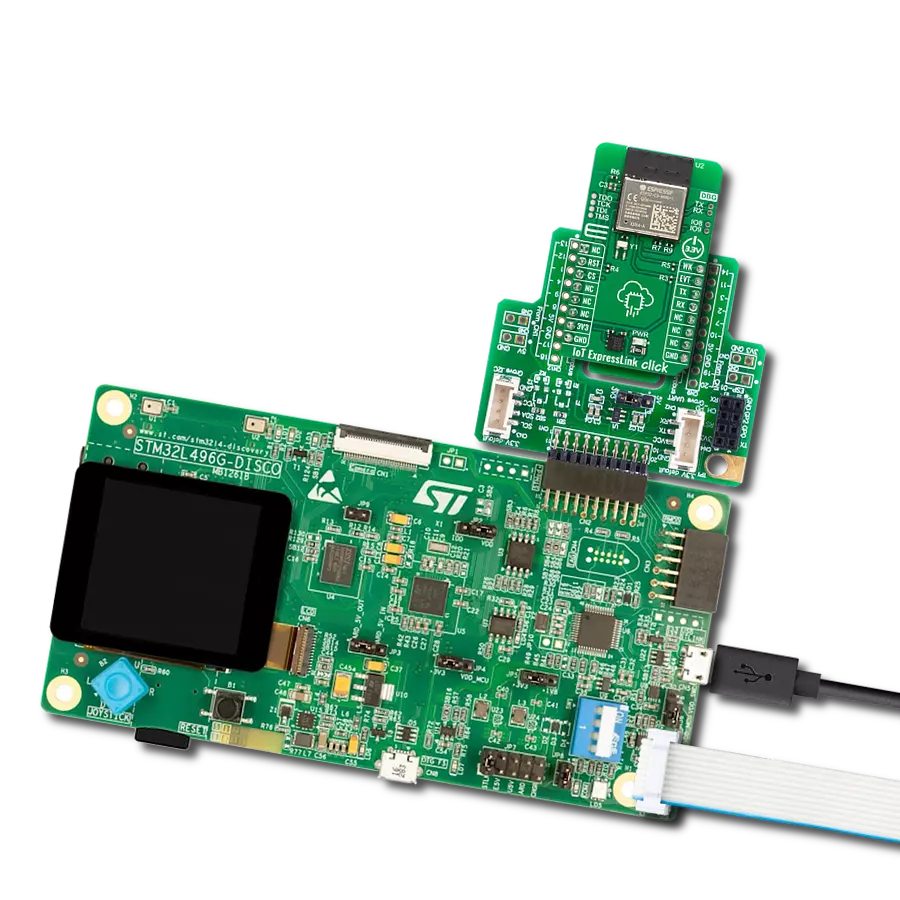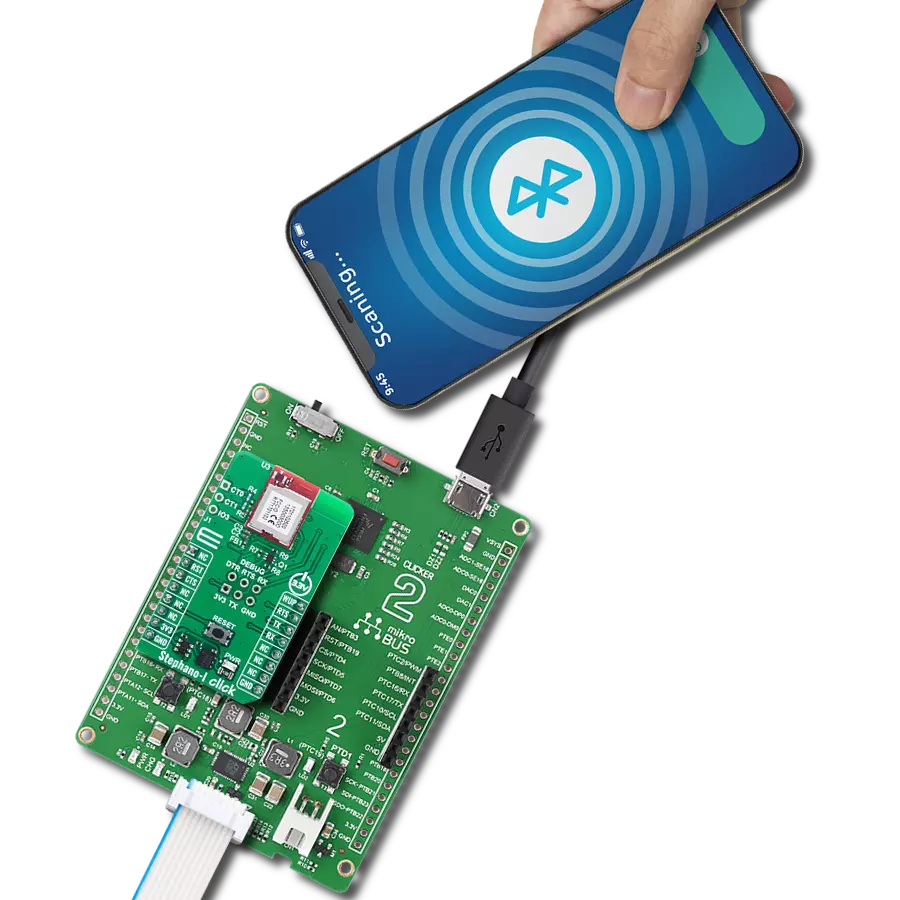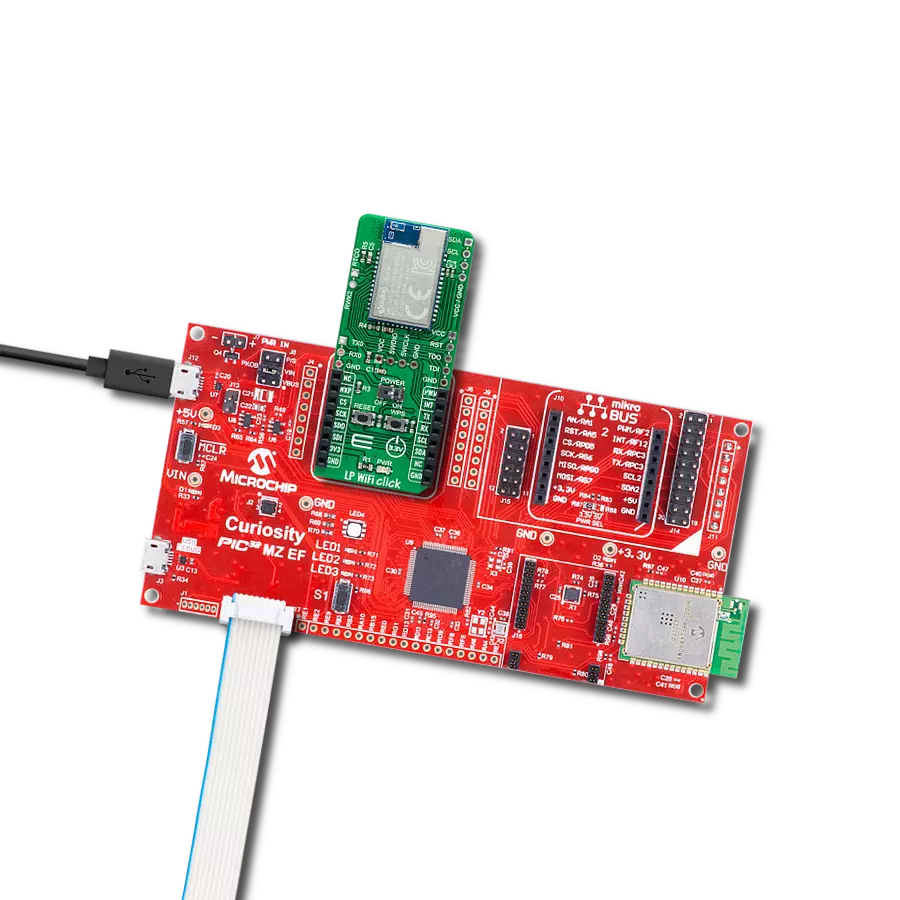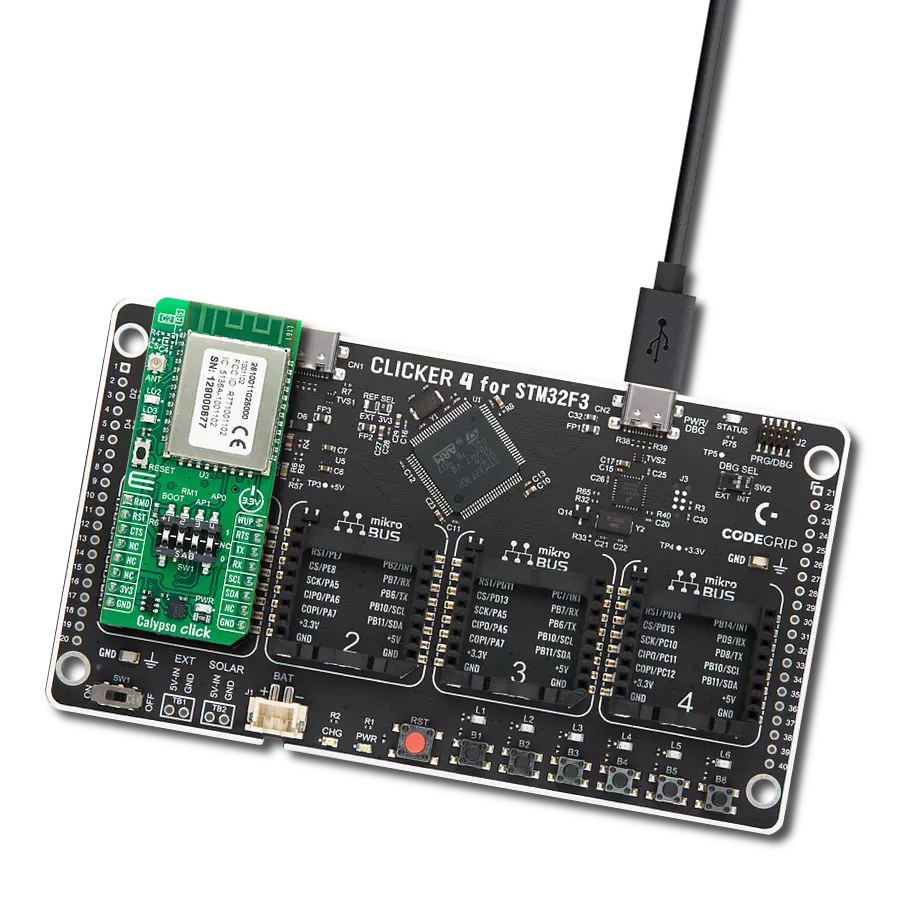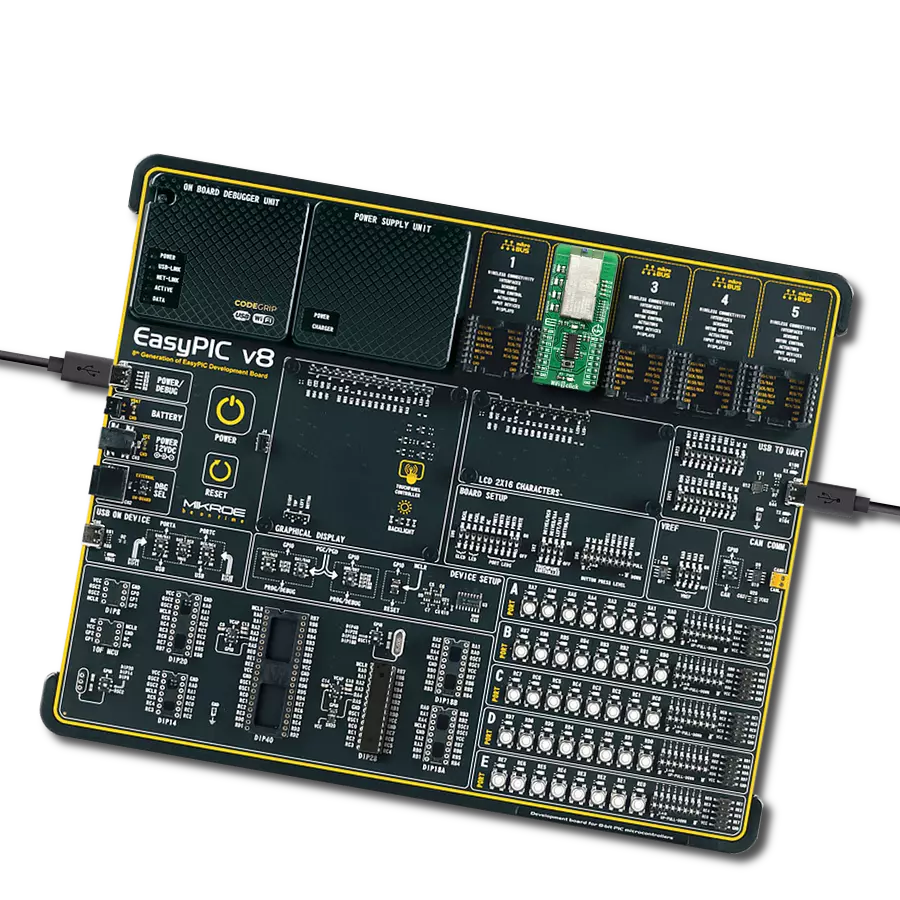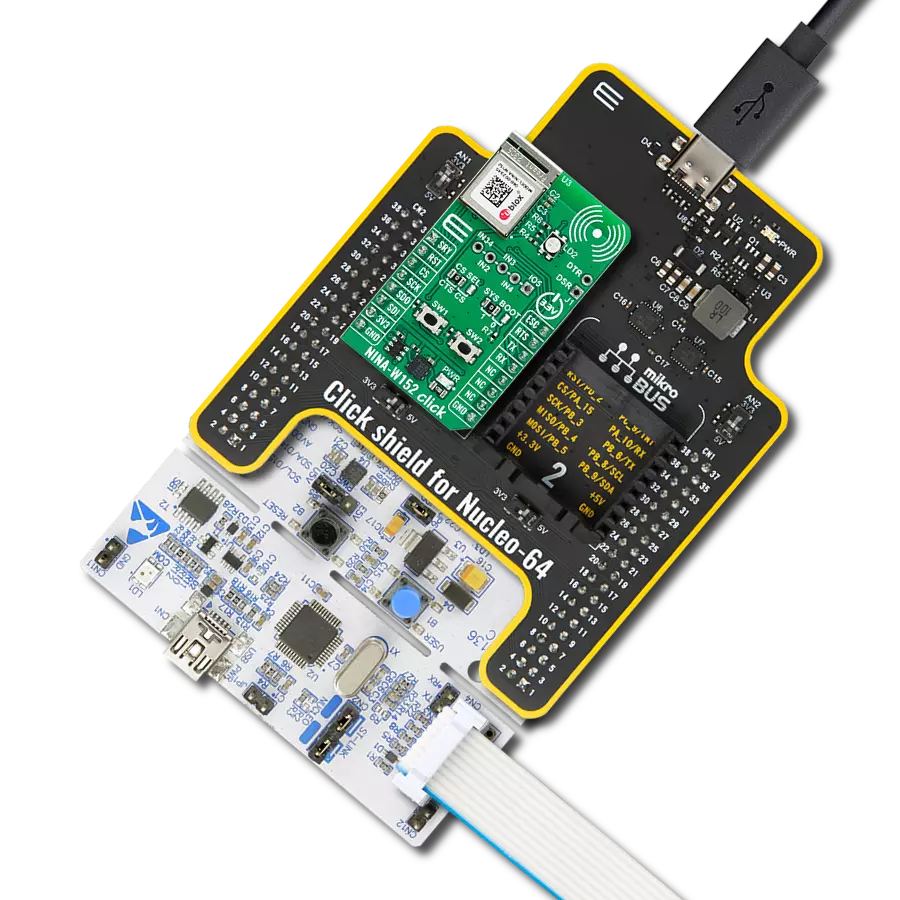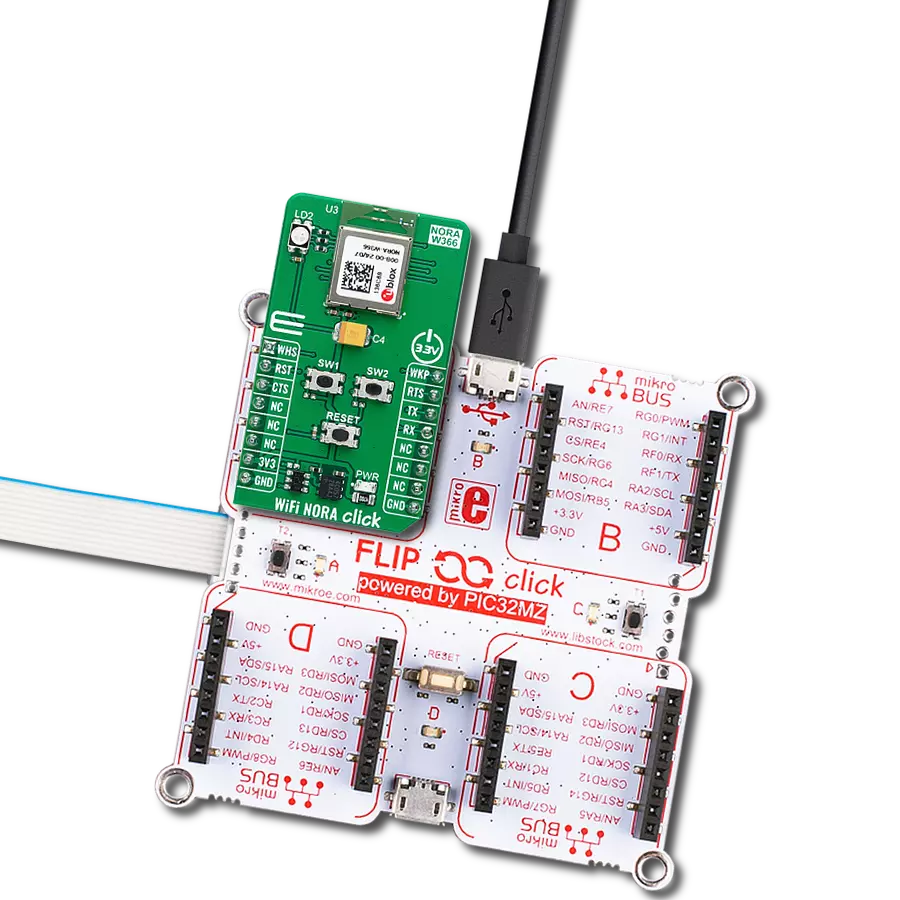实现无线WiFi和BLE技术的轻松集成,同时具备高级安全性和能源效率,非常适合开发智能设备和物联网应用。
A
A
硬件概览
它是如何工作的?
Ai-WB2-12F Click基于Ai-Thinker Technology的Ai-WB2-12F,这是一个WiFi和BLE模块。在其核心是BL602芯片,作为主要处理器。该芯片为模块提供了对WiFi 802.11b/g/n和BLE 5.0协议的支持,具有低功耗32位RISC CPU、276KB RAM以及一系列外围接口,如SDIO、SPI、UART、I2C、IR Remote、PWM、ADC、DAC、PIR和GPIO等。它的设计旨在广泛应用于物联网(IoT)、可穿戴技术、智能家居解决方案等领域。在附加规格方面,该模块具有内置的PCB天线,覆盖了2400到2483.5MHz的频率范围,以及广泛的WiFi安全协议,包括WPS、WEP、WPA、WPA2 Personal、WPA2 Enterprise和WPA3。它
还支持BLE 5.0和蓝牙Mesh,各种操作模式,如Station + BLE和Station + SoftAP + BLE,具有ECC-256签名镜像的安全启动、用于128/192/256位密钥的AES加密引擎、真随机数生成器和用于广泛的加密操作的公钥加速器。该模块支持各种睡眠模式,具有仅12μA的深度睡眠电流,并允许使用通用AT命令进行简单设置。至于板的连接特性,这个Click板™采用UART接口与主机MCU通信,使用标准的UART RX和TX引脚来交换AT命令。默认情况下,它以115200bps的波特率进行通信。此外,该Click板™还配备了一个USB-C连接器,可通过PC进行直接供电和配置。该板还通过与mikroBUS™插座的EN引脚连接的R5电阻(默认情况下未装
载R5电阻)实现了复位功能,具有用于模块启用的EN按钮以及用于固件编程的PROG按钮。RGB二极管用作状态指示器,红色表示IO14的活动IO引脚,绿色表示IO17,蓝色表示IO3。根据用户的需求,这些引脚可以适应各种用途,如SPI、PWM或ADC。可用户配置的IO引脚默认不可用。如果需要使用,请联系Ai-Thinker。此Click板™只能使用3.3V逻辑电压电平。在使用具有不同逻辑电平的MCU之前,板必须执行适当的逻辑电压电平转换。此外,它配备了一个包含函数和示例代码的库,可用作进一步开发的参考。
功能概述
开发板
Nucleo-64 搭载 STM32G431RB MCU 提供了一种经济高效且灵活的平台,供开发者探索新想法并原型设计他们的项目。该板利用 STM32 微控制器的多功能性,使用户能够为他们的项目选择最佳的性能与功耗平衡。它配备了 LQFP64 封装的 STM32 微控制器,并包含了如用户 LED(同时作为 ARDUINO® 信号)、用户和复位按钮,以及 32.768kHz 晶体振荡器用于精确的计时操作等基本组件。Nucleo-64 板设计考虑到扩展性和灵活性,它特有的 ARDUINO® Uno
V3 扩展连接器和 ST morpho 扩展引脚头,提供了对 STM32 I/O 的完全访问,以实现全面的项目整合。电源供应选项灵活,支持 ST-LINK USB VBUS 或外部电源,确保在各种开发环境中的适应性。该板还配备了一个具有 USB 重枚举功能的板载 ST-LINK 调试器/编程器,简化了编程和调试过程。此外,该板设计旨在简化高级开发,它的外部 SMPS 为 Vcore 逻辑供电提供高效支持,支持 USB 设备全速或 USB SNK/UFP 全速,并内置加密功能,提升了项目的功效
和安全性。通过外部 SMPS 实验的专用连接器、 用于 ST-LINK 的 USB 连接器以及 MIPI® 调试连接器,提供了更多的硬件接口和实验可能性。开发者将通过 STM32Cube MCU Package 提供的全面免费软件库和示例得到广泛支持。这些,加上与多种集成开发环境(IDE)的兼容性,包括 IAR Embedded Workbench®、MDK-ARM 和 STM32CubeIDE,确保了流畅且高效的开发体验,使用户能够充分利用 Nucleo-64 板在他们的项目中的能力。
微控制器概述
MCU卡片 / MCU
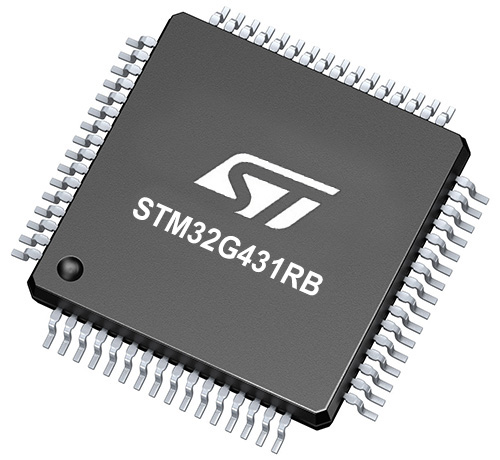
建筑
ARM Cortex-M4
MCU 内存 (KB)
128
硅供应商
STMicroelectronics
引脚数
64
RAM (字节)
32k
你完善了我!
配件
Click Shield for Nucleo-64 配备了两个专有的 mikroBUS™ 插座,使得所有的 Click board™ 设备都可以轻松地与 STM32 Nucleo-64 开发板连接。这样,Mikroe 允许其用户从不断增长的 Click boards™ 范围中添加任何功能,如 WiFi、GSM、GPS、蓝牙、ZigBee、环境传感器、LED、语音识别、电机控制、运动传感器等。您可以使用超过 1537 个 Click boards™,这些 Click boards™ 可以堆叠和集成。STM32 Nucleo-64 开发板基于 64 引脚封装的微控制器,采用 32 位 MCU,配备 ARM Cortex M4 处理器,运行速度为 84MHz,具有 512Kb Flash 和 96KB SRAM,分为两个区域,顶部区域代表 ST-Link/V2 调试器和编程器,而底部区域是一个实际的开发板。通过 USB 连接方便地控制和供电这些板子,以便直接对 Nucleo-64 开发板进行编程和高效调试,其中还需要额外的 USB 线连接到板子上的 USB 迷你接口。大多数 STM32 微控制器引脚都连接到了板子左右边缘的 IO 引脚上,然后连接到两个现有的 mikroBUS™ 插座上。该 Click Shield 还有几个开关,用于选择 mikroBUS™ 插座上模拟信号的逻辑电平和 mikroBUS™ 插座本身的逻辑电压电平。此外,用户还可以通过现有的双向电平转换器,使用任何 Click board™,无论 Click board™ 是否在 3.3V 或 5V 逻辑电压电平下运行。一旦将 STM32 Nucleo-64 开发板与我们的 Click Shield for Nucleo-64 连接,您就可以访问数百个工作于 3.3V 或 5V 逻辑电压电平的 Click boards™。
使用的MCU引脚
mikroBUS™映射器
“仔细看看!”
Click board™ 原理图
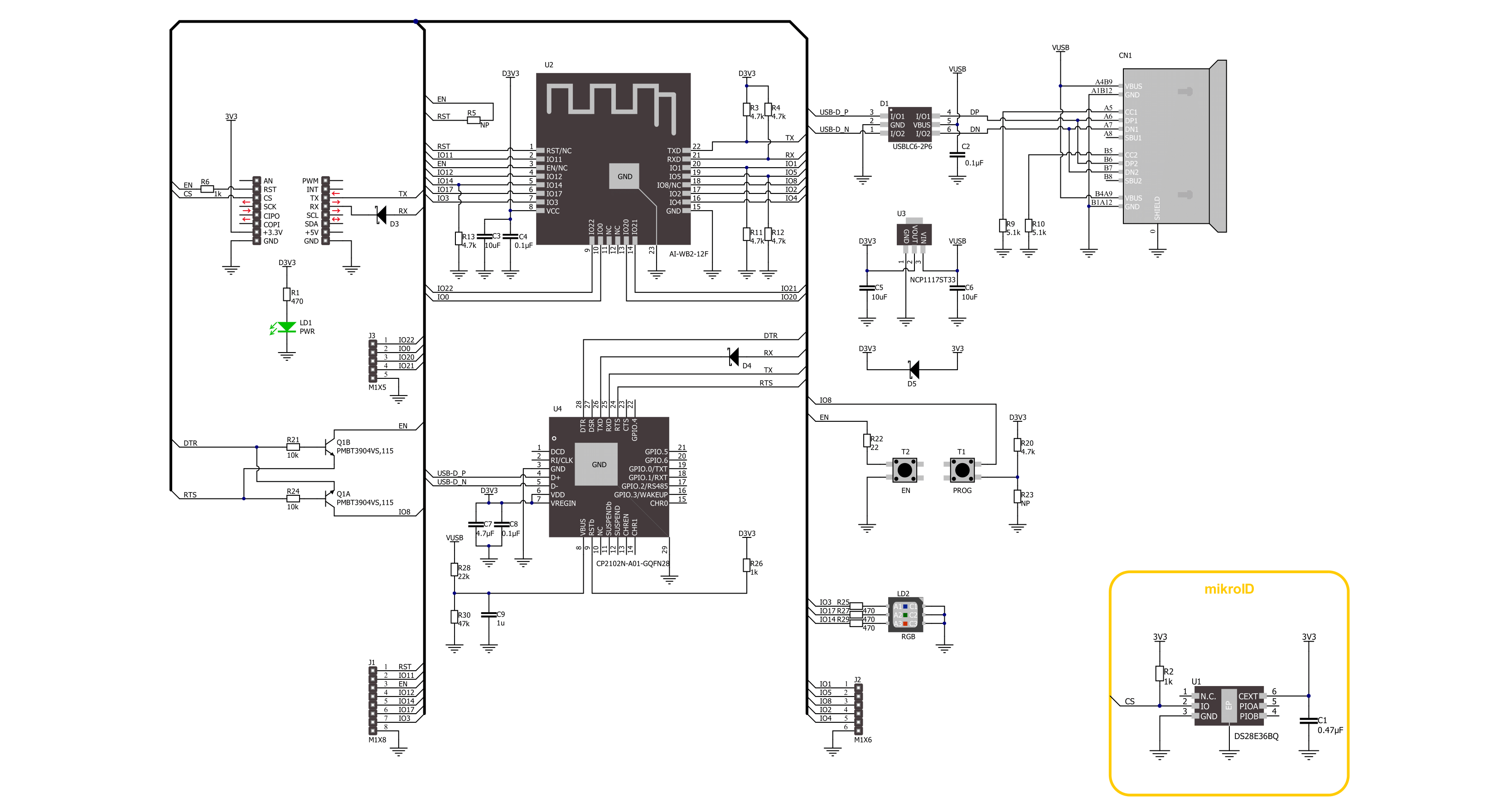
一步一步来
项目组装
软件支持
库描述
该库包含 Ai-WB2-12F Click 驱动程序的 API。
关键功能:
aiwb212f_send_cmd- Ai-WB2-12F发送命令功能aiwb212f_send_cmd_with_par- Ai-WB2-12F带参数发送命令功能aiwb212f_send_cmd_check- Ai-WB2-12F发送命令检查功能
开源
代码示例
完整的应用程序代码和一个现成的项目可以通过NECTO Studio包管理器直接安装到NECTO Studio。 应用程序代码也可以在MIKROE的GitHub账户中找到。
/*!
* @file main.c
* @brief Ai-WB2-12F Click Example.
*
* # Description
* This example demonstrates the use of Ai-WB2-12F Click board by processing
* the incoming data and displaying them on the USB UART.
*
* The demo application is composed of two sections :
*
* ## Application Init
* Initializes the driver, tests the communication, and after that restarts the device, and performs example configuration.
*
* ## Application Task
* Depending on the selected demo example, it sends a TCP/UDP echo server message and receives it or
* creates BLE Client which receives the messages from the connected device.
*
* ## Additional Function
* - static void aiwb212f_clear_app_buf ( void )
* - static void aiwb212f_log_app_buf ( void )
* - static err_t aiwb212f_process ( aiwb212f_t *ctx )
* - static void aiwb212f_rsp_check ( void )
* - static void aiwb212f_error_check ( void )
* - static void aiwb212f_configure_for_example ( void )
* - static void aiwb212f_example ( void )
*
* @note
* We have used the BLE Scanner Android application for the BLE Example test
* and you can find it at the link:
* https://play.google.com/store/apps/details?id=com.macdom.ble.blescanner
*
* @author Stefan Ilic
*
*/
#include "board.h"
#include "log.h"
#include "aiwb212f.h"
// Example selection macros
#define EXAMPLE_TCP_UDP 0 // Example of sending messages to a TCP/UDP echo server
#define EXAMPLE_BLE 1 // BLE Example
#define DEMO_EXAMPLE EXAMPLE_TCP_UDP // Example selection macro
// Message content
#define MESSAGE_CONTENT "Ai-WB2-12F Click board - demo example."
#define MESSAGE_LEN "40"
// TCP/UDP example parameters
#define REMOTE_IP "77.46.162.162" // TCP/UDP echo server IP address
#define REMOTE_PORT "51111" // TCP/UDP echo server port
// WiFi parameters
#define WIFI_SSID "MikroE Public"
#define WIFI_PWD "mikroe.guest"
// GPIO parameters
#define LED_RED_GPIO "5"
#define LED_GREEN_GPIO "6"
#define LED_BLUE_GPIO "7"
// Application buffer size
#define APP_BUFFER_SIZE 200
#define PROCESS_BUFFER_SIZE 200
static aiwb212f_t aiwb212f;
static log_t logger;
static err_t error_flag;
static uint8_t app_buf[ APP_BUFFER_SIZE ] = { 0 };
static int32_t app_buf_len = 0;
/**
* @brief Ai-WB2-12F clearing application buffer.
* @details This function clears memory of application buffer and reset its length.
* @note None.
*/
static void aiwb212f_clear_app_buf ( void );
/**
* @brief Ai-WB2-12F log application buffer.
* @details This function logs data from application buffer to USB UART.
* @note None.
*/
static void aiwb212f_log_app_buf ( void );
/**
* @brief Ai-WB2-12F data reading function.
* @details This function reads data from device and concatenates data to application buffer.
* @return @li @c 0 - Read some data.
* @li @c -1 - Nothing is read.
* See #err_t definition for detailed explanation.
* @note None.
*/
static err_t aiwb212f_process ( void );
/**
* @brief Response check.
* @details This function checks for response and
* returns the status of response.
* @param[in] rsp Expected response.
* @return @li @c 0 - OK response.
* @li @c -1 - Error response.
* @li @c -2 - Timeout error.
* @li @c -3 - Unknown error.
* See #err_t definition for detailed explanation.
*/
static err_t aiwb212f_rsp_check ( uint8_t *rsp );
/**
* @brief Check for errors.
* @details This function checks for different types of
* errors and logs them on UART or logs the response if no errors occured.
* @param[in] error_flag Error flag to check.
*/
static void aiwb212f_error_check ( err_t error_flag );
/**
* @brief Ai-WB2-12F configure for example function.
* @details This function is used to configure device for example.
*/
static void aiwb212f_configure_for_example ( void );
/**
* @brief Ai-WB2-12F execute example function.
* @details This function executes TCP/UDP or BLE example depending on the DEMO_EXAMPLE macro.
*/
static void aiwb212f_example ( void );
void application_init ( void )
{
log_cfg_t log_cfg; /**< Logger config object. */
aiwb212f_cfg_t aiwb212f_cfg; /**< Click config object. */
/**
* Logger initialization.
* Default baud rate: 115200
* Default log level: LOG_LEVEL_DEBUG
* @note If USB_UART_RX and USB_UART_TX
* are defined as HAL_PIN_NC, you will
* need to define them manually for log to work.
* See @b LOG_MAP_USB_UART macro definition for detailed explanation.
*/
LOG_MAP_USB_UART( log_cfg );
log_init( &logger, &log_cfg );
log_info( &logger, " Application Init " );
// Click initialization.
aiwb212f_cfg_setup( &aiwb212f_cfg );
AIWB212F_MAP_MIKROBUS( aiwb212f_cfg, MIKROBUS_1 );
if ( UART_ERROR == aiwb212f_init( &aiwb212f, &aiwb212f_cfg ) )
{
log_error( &logger, " Communication init." );
for ( ; ; );
}
aiwb212f_process( );
aiwb212f_clear_app_buf( );
aiwb212f_hw_reset( &aiwb212f );
error_flag = aiwb212f_rsp_check( AIWB212F_RSP_READY );
aiwb212f_error_check( error_flag );
// Check communication
aiwb212f_send_cmd( &aiwb212f, AIWB212F_CMD_AT );
error_flag = aiwb212f_rsp_check( AIWB212F_RSP_OK );
aiwb212f_error_check( error_flag );
// Restart device
aiwb212f_send_cmd( &aiwb212f, AIWB212F_CMD_AT_SW_RESET );
error_flag = aiwb212f_rsp_check( AIWB212F_RSP_READY );
aiwb212f_error_check( error_flag );
aiwb212f_configure_for_example( );
log_info( &logger, " Application Task " );
}
void application_task ( void )
{
aiwb212f_example( );
}
int main ( void )
{
/* Do not remove this line or clock might not be set correctly. */
#ifdef PREINIT_SUPPORTED
preinit();
#endif
application_init( );
for ( ; ; )
{
application_task( );
}
return 0;
}
static void aiwb212f_clear_app_buf ( void )
{
memset( app_buf, 0, app_buf_len );
app_buf_len = 0;
}
static void aiwb212f_log_app_buf ( void )
{
for ( int32_t buf_cnt = 0; buf_cnt < app_buf_len; buf_cnt++ )
{
log_printf( &logger, "%c", app_buf[ buf_cnt ] );
}
}
static err_t aiwb212f_process ( void )
{
uint8_t rx_buf[ PROCESS_BUFFER_SIZE ] = { 0 };
int32_t overflow_bytes = 0;
int32_t rx_cnt = 0;
int32_t rx_size = aiwb212f_generic_read( &aiwb212f, rx_buf, PROCESS_BUFFER_SIZE );
if ( ( rx_size > 0 ) && ( rx_size <= APP_BUFFER_SIZE ) )
{
if ( ( app_buf_len + rx_size ) > APP_BUFFER_SIZE )
{
overflow_bytes = ( app_buf_len + rx_size ) - APP_BUFFER_SIZE;
app_buf_len = APP_BUFFER_SIZE - rx_size;
memmove ( app_buf, &app_buf[ overflow_bytes ], app_buf_len );
memset ( &app_buf[ app_buf_len ], 0, overflow_bytes );
}
for ( rx_cnt = 0; rx_cnt < rx_size; rx_cnt++ )
{
if ( rx_buf[ rx_cnt ] )
{
app_buf[ app_buf_len++ ] = rx_buf[ rx_cnt ];
}
}
return AIWB212F_OK;
}
return AIWB212F_ERROR;
}
static err_t aiwb212f_rsp_check ( uint8_t *rsp )
{
uint32_t timeout_cnt = 0;
uint32_t timeout = 120000;
aiwb212f_clear_app_buf( );
aiwb212f_process( );
while ( ( 0 == strstr( app_buf, rsp ) ) &&
( 0 == strstr( app_buf, AIWB212F_RSP_ERROR ) ) )
{
aiwb212f_process( );
if ( timeout_cnt++ > timeout )
{
aiwb212f_clear_app_buf( );
return AIWB212F_ERROR_TIMEOUT;
}
Delay_ms ( 1 );
}
Delay_ms ( 100 );
aiwb212f_process( );
if ( strstr( app_buf, rsp ) )
{
return AIWB212F_OK;
}
else if ( strstr( app_buf, AIWB212F_RSP_ERROR ) )
{
return AIWB212F_ERROR_CMD;
}
else
{
return AIWB212F_ERROR_UNKNOWN;
}
}
static void aiwb212f_error_check ( err_t error_flag )
{
#define LED_STATE_ON "1"
#define LED_STATE_OFF "0"
uint8_t command_data[ 10 ] = { 0 };
switch ( error_flag )
{
case AIWB212F_OK:
{
aiwb212f_log_app_buf( );
break;
}
case AIWB212F_ERROR:
{
log_error( &logger, " Overflow!" );
aiwb212f_set_gpio( &aiwb212f, LED_RED_GPIO, LED_STATE_ON );
Delay_ms ( 500 );
aiwb212f_set_gpio( &aiwb212f, LED_RED_GPIO, LED_STATE_OFF );
break;
}
case AIWB212F_ERROR_TIMEOUT:
{
log_error( &logger, " Timeout!" );
aiwb212f_set_gpio( &aiwb212f, LED_RED_GPIO, LED_STATE_ON );
Delay_ms ( 500 );
aiwb212f_set_gpio( &aiwb212f, LED_RED_GPIO, LED_STATE_OFF );
break;
}
case AIWB212F_ERROR_CMD:
{
log_error( &logger, " CMD!" );
aiwb212f_set_gpio( &aiwb212f, LED_RED_GPIO, LED_STATE_ON );
Delay_ms ( 500 );
aiwb212f_set_gpio( &aiwb212f, LED_RED_GPIO, LED_STATE_OFF );
break;
}
case AIWB212F_ERROR_UNKNOWN:
default:
{
log_error( &logger, " Unknown!" );
aiwb212f_set_gpio( &aiwb212f, LED_RED_GPIO, LED_STATE_ON );
Delay_ms ( 500 );
aiwb212f_set_gpio( &aiwb212f, LED_RED_GPIO, LED_STATE_OFF );
break;
}
}
log_printf( &logger, "- - - - - - - - - - - - - - - -\r\n" );
Delay_ms ( 500 );
}
static void aiwb212f_configure_for_example ( void )
{
#if ( EXAMPLE_TCP_UDP == DEMO_EXAMPLE )
#define WIFI_MODE "1,0"
aiwb212f_send_cmd_with_par( &aiwb212f, AIWB212F_CMD_AT_WMODE, WIFI_MODE );
error_flag = aiwb212f_rsp_check( AIWB212F_RSP_OK );
aiwb212f_error_check( error_flag );
// Connect to WiFi
#define WIFI_CONNECTED "+EVENT:WIFI_GOT_IP"
uint8_t wifi_data[ 50 ] = { 0 };
strcpy( wifi_data, WIFI_SSID );
strcat( wifi_data, "," );
strcat( wifi_data, WIFI_PWD );
aiwb212f_send_cmd_with_par( &aiwb212f, AIWB212F_CMD_AT_WJAP, wifi_data );
error_flag = aiwb212f_rsp_check( AIWB212F_RSP_OK );
error_flag = aiwb212f_rsp_check( WIFI_CONNECTED );
aiwb212f_error_check( error_flag );
#elif ( EXAMPLE_BLE == DEMO_EXAMPLE )
#define DEVICE_NAME "Ai-WB2-12F Click"
aiwb212f_send_cmd_with_par( &aiwb212f, AIWB212F_CMD_AT_BLENAME, DEVICE_NAME );
error_flag = aiwb212f_rsp_check( AIWB212F_RSP_OK );
aiwb212f_error_check( error_flag );
aiwb212f_send_cmd_with_par( &aiwb212f, AIWB212F_CMD_AT_BLEMODE, "0" );
error_flag = aiwb212f_rsp_check( AIWB212F_RSP_OK );
aiwb212f_error_check( error_flag );
#define DEVICE_CONNECT "+EVENT:BLE_CONNECT"
log_printf( &logger, " Please connect your device\r\n" );
do
{
aiwb212f_process();
aiwb212f_set_gpio( &aiwb212f, LED_BLUE_GPIO, LED_STATE_ON );
Delay_ms ( 500 );
aiwb212f_set_gpio( &aiwb212f, LED_BLUE_GPIO, LED_STATE_OFF );
}
while ( !strstr( app_buf, DEVICE_CONNECT ) );
Delay_ms ( 100 );
aiwb212f_clear_app_buf( );
log_printf( &logger, "- - - - - - - - - - - - - - - -\r\n" );
#else
#error "No demo example selected"
#endif
}
static void aiwb212f_example ( void )
{
#if ( EXAMPLE_TCP_UDP == DEMO_EXAMPLE )
uint8_t command_data[ APP_BUFFER_SIZE ] = { 0 };
#define TCP_CLIENT "4"
#define UDP_CLIENT "2"
#define CON_ID "1"
#define KEEP_ALIVE "1"
aiwb212f_set_gpio( &aiwb212f, LED_BLUE_GPIO, LED_STATE_ON );
Delay_ms ( 500 );
aiwb212f_set_gpio( &aiwb212f, LED_BLUE_GPIO, LED_STATE_OFF );
log_printf( &logger, " TCP Example \r\n" );
log_printf( &logger, "- - - - - - - - - - - - - - - -\r\n" );
strcpy( command_data, TCP_CLIENT );
strcat( command_data, "," );
strcat( command_data, REMOTE_IP );
strcat( command_data, "," );
strcat( command_data, REMOTE_PORT );
strcat( command_data, "," );
strcat( command_data, KEEP_ALIVE );
strcat( command_data, "," );
strcat( command_data, CON_ID );
aiwb212f_send_cmd_with_par( &aiwb212f, AIWB212F_CMD_AT_SOCKET, command_data );
error_flag = aiwb212f_rsp_check( AIWB212F_RSP_OK );
aiwb212f_error_check( error_flag );
aiwb212f_send_cmd_check( &aiwb212f, AIWB212F_CMD_AT_SOCKET );
error_flag = aiwb212f_rsp_check( AIWB212F_RSP_OK );
aiwb212f_error_check( error_flag );
strcpy( command_data, CON_ID );
strcat( command_data, "," );
strcat( command_data, MESSAGE_LEN );
strcat( command_data, "," );
strcat( command_data, MESSAGE_CONTENT );
aiwb212f_send_cmd_with_par( &aiwb212f, AIWB212F_CMD_AT_SOCKETSENDLINE, command_data );
error_flag = aiwb212f_rsp_check( AIWB212F_RSP_OK );
aiwb212f_error_check( error_flag );
aiwb212f_send_cmd_with_par( &aiwb212f, AIWB212F_CMD_AT_SOCKETREAD, CON_ID );
error_flag = aiwb212f_rsp_check( AIWB212F_RSP_OK );
aiwb212f_error_check( error_flag );
aiwb212f_send_cmd_with_par( &aiwb212f, AIWB212F_CMD_AT_SOCKETDEL, CON_ID );
error_flag = aiwb212f_rsp_check( AIWB212F_RSP_OK );
aiwb212f_error_check( error_flag );
aiwb212f_set_gpio( &aiwb212f, LED_BLUE_GPIO, LED_STATE_ON );
Delay_ms ( 500 );
aiwb212f_set_gpio( &aiwb212f, LED_BLUE_GPIO, LED_STATE_OFF );
// UDP mode doesn't support read function
log_printf( &logger, " UDP Example \r\n" );
log_printf( &logger, "- - - - - - - - - - - - - - - -\r\n" );
strcpy( command_data, UDP_CLIENT );
strcat( command_data, "," );
strcat( command_data, REMOTE_IP );
strcat( command_data, "," );
strcat( command_data, REMOTE_PORT );
strcat( command_data, "," );
strcat( command_data, KEEP_ALIVE );
strcat( command_data, "," );
strcat( command_data, CON_ID );
aiwb212f_send_cmd_with_par( &aiwb212f, AIWB212F_CMD_AT_SOCKET, command_data );
error_flag = aiwb212f_rsp_check( AIWB212F_RSP_OK );
aiwb212f_error_check( error_flag );
aiwb212f_send_cmd_check( &aiwb212f, AIWB212F_CMD_AT_SOCKET );
error_flag = aiwb212f_rsp_check( AIWB212F_RSP_OK );
aiwb212f_error_check( error_flag );
strcpy( command_data, CON_ID );
strcat( command_data, "," );
strcat( command_data, MESSAGE_LEN );
strcat( command_data, "," );
strcat( command_data, MESSAGE_CONTENT );
aiwb212f_send_cmd_with_par( &aiwb212f, AIWB212F_CMD_AT_SOCKETSENDLINE, command_data );
error_flag = aiwb212f_rsp_check( AIWB212F_RSP_OK );
aiwb212f_error_check( error_flag );
aiwb212f_send_cmd_with_par( &aiwb212f, AIWB212F_CMD_AT_SOCKETDEL, CON_ID );
error_flag = aiwb212f_rsp_check( AIWB212F_RSP_OK );
aiwb212f_error_check( error_flag );
// 10 seconds delay
Delay_ms ( 1000 );
Delay_ms ( 1000 );
Delay_ms ( 1000 );
Delay_ms ( 1000 );
Delay_ms ( 1000 );
Delay_ms ( 1000 );
Delay_ms ( 1000 );
Delay_ms ( 1000 );
Delay_ms ( 1000 );
Delay_ms ( 1000 );
#elif ( EXAMPLE_BLE == DEMO_EXAMPLE )
aiwb212f_process();
if ( app_buf_len > 0 )
{
log_printf( &logger, "%s", app_buf );
aiwb212f_clear_app_buf( );
}
#else
#error "No demo example selected"
#endif
}
// ------------------------------------------------------------------------ END
额外支持
资源
类别:无线网络
